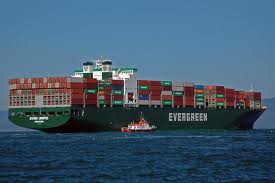
As latest statistics released from the major economies suggest slowdown in global economy ahead, most research houses have sounded cautious note on Asian
container- shipping sector for the second half of this year.
Recent new flows within the Asian container-shipping industry do not bode well for its outlook. On the one hand, liners like Maersk and MSC have announce their decision to delay freight rate hikes, indicating weak trading conditions, continued near-term volatility, and limited rate upside in the coming weeks. On the other hand, reports that more than one million TEUs (twentyfoot equivalent units) of shipbuilding had already been ordered in the first five month this year, prompted some market watchers to express concern with the potential over-capacity problem in the Asian container-shipping industry
Citigroup Equity Research said the Asian container-shipping sector is "about market share gains for now." The delay in freight rate hikes dashed hopes of an earlier rate recovery by June 2011, and Citigroup added the delay "may put more pressure on smaller, less cost-competitive players."
Indeed, the smaller liners have already taken action in the face of increasingly challenging market. With the base freight rate from China to Europe now falling to less than 200 U.S. dollars per TEU, shipping companies like Wan Hai and Pacific International Lines are reportedly suspending one of their joint services, from Asia to either Northern Europe or the Black Sea, due to poor market conditions.
CIMB Research also described "the present situation is much worse than our expectations at the start of the year." The research house now expected "carriers to begin canceling services, redeploying capacity to other trades, or laying up ships if the situation continues."
As for the surge in new-building orders from Asian container- shipping sector, CIMB Research expressed concern that liners are " repeating the mistakes of the past." The supply could grow faster than demand in next year and even 2013 based on CIMB's own revised demand-supply calculations, which was not what the research house had expected at the start of this year.
Nomura Equity Research no longer foresaw freight rates to rebound to profitable levels as a muted and short peak season is expected in the third quarter for Asian container-shipping operators, given that increased supply of ships could prevent carriers from successfully pushing through peak season surcharges or rate increases.
"Not only is carrier behavior hurting freight rates, cost inflation, especially oil prices, is also hurting margins," said Nomura Equity Research. "Oil is the largest cost item (accounting for 20 to 25 percent of total costs) and bunker oil has increased by 28 percent since the end of 2010. Without pricing power, oil surcharges are unlikely to offset the higher oil prices."
However, not all research houses are pessimistic about the outlook of the industry. Credit Suisse Research said that Asian container-shipping demand is seasonally stronger in the second half, and new vessel delivery should slow down in the second half after peaking in the second quarter, which will allay market fear of over-capacity problem.
Besides, Credit Suisse believed that the recent economic weakness is a "mid-cycle slowdown." Its economists still forecast 3.9 percent U.S. GDP growth in the second half, and 4.3 percent globally for the whole year, which the research house argued will eventually bode well for Asian liners.
Source: Xinhua
We use cookies to improve your experience. By continuing to use our site, you accept our Cookies, Privacy Policy,Terms and Conditions. Close X